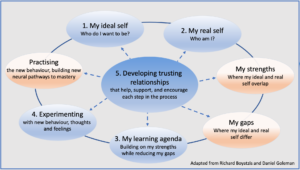11 Apr Intentional change
Any significant personal or professional change that produces sustained results lies in self-directed learning. This means intentionally developing an aspect of who you are or who you want to be, or both. The change may relate to you taking on a major new role, making a big life-career move or developing behaviours to enhance your effectiveness as a leader.
The essence of Richard Boyatzis’ intentional change model is [a] achieving changes that [b] you want in your behaviours, habits, skills and perspectives and that [c] are sustained over time.

The intentional change model (above) involves what Boyatzis terms five discoveries, i.e. what you identify and learn through exploration and reflection (in blue) and the insights emerging from the process of discovery (in orange).
Applying the intentional change model
Let’s look at each step in detail and how to follow each one through.
1. Discover your ideal self. The first step in making an intentional change is to define your ideal self by forming a clear sense of who you would like to be and what you’d like to achieve. This is your vision. The image has the power to evoke passion and provide the fuel and drive your need to work through the process of change.
Think about what kind of person or leader you’d like to be. Be specific: Would you like to be more empathic? Feel more energetic, engaged or motivated? Have more patience, compassion? Show more kindness? Be more assertive? Enjoy greater confidence? Develop a better work-life balance?
What are your hopes and aspirations? What roles do you want to play? How do you want to be seen? What legacy do you want to leave? Identify short- and long-term goals. What excites you during this process? Discard goals about which you don’t feel enthusiastic – keep exploring until you find ones you’d genuinely like to achieve. Write out your dreams, however wild they may seem. It’s helpful to capture all your hopes and aspirations at this stage of the process, even if you later decide that some of them are not immediately achievable. Next…
2. Discover your real self. Define your real self, the person you are now. Look in the mirror. This can be challenging because many of us have trouble seeing ourselves as we are, our strengths and weaknesses. Use tools like a personal SWOT analysis, personality inventories like the MBTI.
Or simply? Explore your current attitudes, assumptions, behaviours, and habits and answer: What do you like most and least about yourself? What to keep and what needs to change? Where have you been most successful, effective and happy? What were you doing? What was the reverse?
Solicit feedback from family, colleagues, the person you report to, and other key stakeholders. Do 360-degree feedback.
3. Create your learning agenda. Once you’ve defined who you are and who you’d like to be, you can create a learning agenda to bridge the gap between your current reality (who you are) with your vision (who you want to be). Start by playing to your strengths and then addressing weaker areas. Your learning agenda is akin to a personal development plan. It will help you monitor progress by reflecting on what is working and what needs to change, help you stay focused and on track, and reward yourself for achievements.
Your plan should include no more than three or four SMART goals (Specific, Measurable, Actionable, Realistic and Time-bound). For each goal, identify two or three actions and the resources required to achieve the goal. Resources could include financial support for further education and development opportunities such as secondments, mentoring and external coaching.
4. Experiment and practise new ways of being. This discovery is about experimenting – that is, find compelling ways to learn – and then test your new knowledge, skills, or attitudes. Experimenting with new behaviours, trying out a new role, extending yourself out of your comfort zone requires courage and perseverance. Plus, having the resilience to bounce back from setbacks and start again with renewed vigour.
Once you have settled on what the new ways of doing things are (those that will get you to where you want to be) that you’re heading in the right direction, with the right role, it’s time to practise. Practising will help you turn the changes you’ve made into new ways of being, i.e. new habits. Whether you’re learning a new skill, starting another job, or changing an attitude or belief, do something – however small – every day that reinforces the changes you’ve made.
5. Develop trusting relationships and get others to help you. None of us gets to where we want to be on our own. Friends, family, work colleagues and old and new networks can encourage us and provide support through challenging times. Share with a few of those you trust what you want to do and why you want to do it. Confide in them. Share your learning agenda and invite their support. Find a mentor or coach.
By building trusting relationships you can help others develop and get them to help you do the same.
Conclusion
Ideally, your progression through the discoveries will excite and motivate you. I have seen clients develop a sense of urgent passion to pursue their dreams and become self-directed learners. It’s the way to go!
More this topic
- The New Leaders by Daniel Goleman, Richard Boyatzis and Annie McKee is a richly researched and well-documented exposition of intentional change theory and its many applications.
- My post Networking: Invest in the right relationships at the right time.


